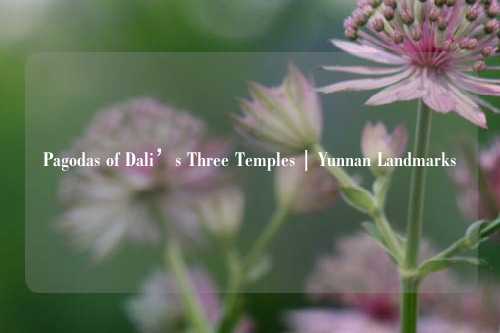Pagodas of Dali’s Three Temples | Yunnan Landmarks
The History and Architecture of Dali’s Three Temples
The city of Dali, once the capital of the Kingdom of Dali during the Song and Yuan dynasties, is a treasure trove of and historical wonders. Among its many attractions, the Three Pagodas stand out as some of the most iconic and enduring landmarks in Yunnan Province. These pagodas, nestled in the Dali Prefecture, have withstood the test of time for centuries, serving as testaments to the region’s rich history and spiritual heritage.

A Glimpse into Yunnan’s Past
The Three Pagodas, also known as the Dali Three Pagodas, are located approximately 15 kilometers northwest of Dali Old Town. Constructed during the Taihe period (927–937) of the Kingdom of Dali, these pagodas were originally part of a single temple complex. The central pagoda, known as the Thousand-Earthen Pagoda, is the largest and most prominent of the three. It was built by the king of Dali, Duan Siping, as a grand gesture to promote Buddhism and showcase his power and piety.
The other two pagodas, the West and East Pagodas, were constructed later, during the reign of subsequent kings. Together, they form a symmetrical trio, with the central pagoda flanked by its two smaller counterparts. The entire complex is a stunning example of the fusion of Chinese and Tibetan architectural styles, reflecting the diverse influences that shaped Yunnan during the Dali Kingdom era.
Architectural Marvels
The Three Pagodas are not only historical landmarks but also architectural marvels. The central pagoda, standing at 69.6 meters tall, is a tall, slim structure with thirteen tiers, each adorned with carvings of Buddhist figures and motifs. Its design is reminiscent of the pagodas found in India, showcasing the influence of Buddhism on the region.
The West and East Pagodas, while smaller, are equally impressive. The West Pagoda, known as the Chongshengsi Pagoda, is 60 meters tall and features ten tiers. It is particularly noted for its octagonal shape, a departure from the square or circular designs of other pagodas. The East Pagoda, or the Qianfosi Pagoda, is slightly shorter but equally beautiful, with its nine tiers showcasing stone carvings of flora and fauna.
The construction of these pagodas involved advanced engineering techniques for their time, including the use of brick and stone masonry, as well as the use of dougong (wooden brackets) to support the structure. The stability and durability of the pagodas are a testament to the skill and ingenuity of the ancient builders.
A Spiritual Retreat
Beyond their architectural significance, the Three Pagodas hold deep spiritual meaning for both Buddhists and visitors alike. As sacred sites, they have served as centers for Buddhist worship and meditation for centuries. The pagodas are adorned with numerous Buddha statues, carvings, and religious paintings, all of which contribute to the serene and reverent atmosphere of the site.
The central pagoda, in particular, is a place of pilgrimage for Buddhists. Inside, visitors can explore the various levels, each dedicated to different aspects of Buddhist teachings and practices. The upper levels offer panoramic views of the surrounding landscape, providing a sense of tranquility and connection to the divine.
Cultural Significance and Modern-Day Attractions
The Three Pagodas of Dali are more than just historical sites; they are vibrant symbols of Yunnan’s heritage. Over the centuries, the pagodas have played a role in preserving the region’s history, art, and spirituality. Today, they continue to attract countless visitors, who come not only to admire their beauty but also to learn about the rich history and culture of Yunnan Province.
Preserving Yunnan’s Legacy
The Three Pagodas serve as a window into the past, offering insights into the lives of the people who lived during the Dali Kingdom. The carvings, statues, and paintings found within the pagodas provide clues about the artistic styles, religious practices, and daily lives of the ancient inhabitants of Yunnan.
Moreover, the pagodas have been in preserving the region’s identity. As Yunnan is a melting pot of diverse ethnic groups and traditions, the Three Pagodas stand as a reminder of the area’s position at the crossroads of East and West. The blending of Chinese, Tibetan, and Indian influences is evident in the architecture, art, and religious practices associated with the pagodas, making them a true reflection of Yunnan’s multi heritage.
A Destination for Travelers
For modern-day travelers, the Three Pagodas are a must-visit destination. They offer a opportunity to experience the magic of Yunnan’s history and culture firsthand. Visitors can explore the pagodas at their own pace, soaking in the serene atmosphere and taking in the breathtaking views of the surrounding mountains and valleys.
The site is particularly popular during special occasions, such as Buddhist festivals and celebrations. During these times, the pagodas are decorated with colorful lanterns and flags, and monks perform rituals and prayers. These events provide a glimpse into the living traditions that have been passed down through generations, highlighting the enduring relevance of the Three Pagodas in contemporary society.
A Symbol of Resilience
The Three Pagodas also symbolize the resilience and enduring spirit of the people of Yunnan. Over the centuries, the pagodas have survived numerous natural disasters, wars, and changes in political power. Despite these challenges, they continue to stand tall, serving as a source of inspiration and pride for the local community.
Today, the Three Pagodas are a focal point of Dali’s landscape, drawing visitors from around the world. They are a testament to the region’s rich heritage and a reminder of the importance of preserving history for future generations.
Conclusion
The Pagodas of Dali’s Three Temples are more than just architectural marvels; they are windows into Yunnan’s past and symbols of its and spiritual legacy. These ancient structures, with their designs and rich history, continue to captivate the imagination of visitors and scholars alike.
As you explore the Three Pagodas, you will not only be marveling at their beauty but also gaining a deeper understanding of the region’s history, art, and spiritual traditions. Whether you are a history enthusiast, a traveler, or simply someone looking for a spiritual retreat, the Three Pagodas of Dali offer an unforgettable experience that will stay with you long after your visit.
So, the next time you find yourself in Yunnan, make sure to pay a visit to the Three Pagodas of Dali. Let their beauty, history, and significance inspire you and transport you back in time to an era of faith, art, and resilience.
















